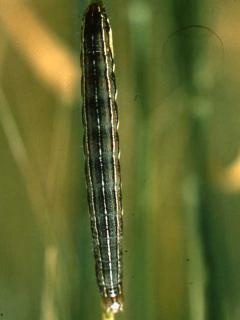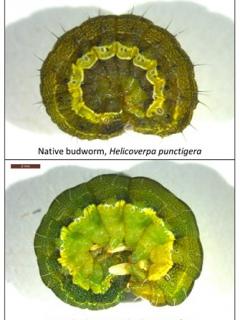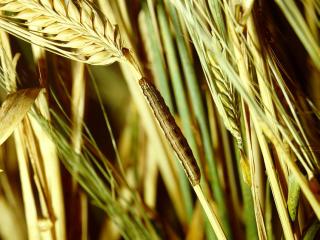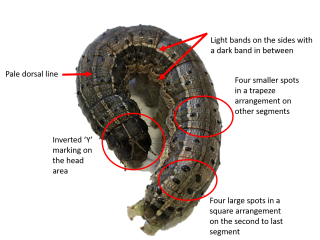Identifying caterpillars in cereal crops
- West Casuarinas
Tony Rosser (Great Northern Rural) has recently found low numbers of armyworm caterpillars in wheat and barley crops near West Casuarinas.
In Western Australia, the most common types of caterpillars which damage cereal crops during winter or spring are lesser budworm (Heliothis punctifera) and armyworms (multiple species).
Armyworm

Armyworm caterpillars are fat and smooth and may be distinguished by the three parallel white stripes on the collar just behind the head. The first visible sign of armyworm caterpillars is often their green to straw-coloured droppings, about the size of a match head, found on the ground between the cereal rows.
Armyworm caterpillars are most damaging in barley crops close to harvest. When barley crops are maturing in spring, large armyworm caterpillars climb plants and can chew through the stems, causing the heads to fall to the ground. Damage to wheat and oat crops occurs less frequently and is usually minor compared to damage in barley because the stems are thicker and leaf defoliation does not usually result in yield loss. Armyworms are seldom a serious problem in pastures.
Assessing the number of armyworm in a cereal crop can be difficult, as their movements will vary with weather conditions and feeding preference. Sometimes they are found sheltering on the ground and under leaf litter whilst on other days they will be high up on the plants or on the heads, and easily picked up using sweep nets. Larger caterpillars often prefer to hide during the day and feed at night.
The economic level for spraying armyworm in mature barley is about three large armyworm grubs per square metre of crop. The threshold for wheat or oats is much higher as only grains are consumed and heads are very rarely dropped. Spray thresholds in these crops are more like 10 grubs per square metre of crop. For more armyworm threshold information, refer to DPIRD’s Management of armyworm in cereal crops page.
A number of effective insecticides are registered for the control of armyworm if required (see DPIRD’s 2022 Winter Spring Insecticide Guide). However, their effectiveness is dependent on good penetration into the crop. This can be difficult to achieve in high-yielding, thick canopy crops, especially when caterpillars are resting under leaf litter at the base of plants. Spraying late in the afternoon or evening is recommended as armyworm is predominately a night feeder. Spray withholding periods need to be observed.
Growers should be mindful to distinguish the more common armyworms from the recently introduced Fall armyworm caterpillars. The FAW differs from our endemic species of armyworm by having a spotted pattern of dots and a distinctive inverted white Y marking on the head area, which the common armyworm caterpillars do not have. For more information refer to the 2020 PestFax Issue 14 article How to distinguish Fall armyworm caterpillars from other endemic caterpillars.
Lesser and native budworm

Lesser budworm (which is known to attack cereal crops) caterpillars can be distinguished from native budworm caterpillars by comparing the colour of the hairs along their bodies. Lesser budworm caterpillars have white hairs while native budworm have black hairs (see image above).
Native budworm has been known on occasion to chew into glumes and flag leaves on wheat plants, particularly in the Geraldton port zone. Although cereals are not a common host of native budworm, their presence in cereal crops and feeding in the past has likely come from a combination of abnormally high moth pressure from long distance migrations and moths laying eggs on wild radish and volunteer canola, lupin or pulse plants in the wheat crop which then transfer onto wheat plants. Preliminary DPIRD results from a GRDC co-funded project has shown that native budworm moths are heavily deterred from laying eggs on wheat plants when forced to do so within insect-proof cages. When larvae were forced onto wheat plants, variable levels of damage occurred from very little leaf damage to approximately half of the flag leaf chewed and about half of glumes chewed into. This damage was done from one larva per plant. However, many of the larvae either died prematurely or pupated at a much smaller size than on a favoured host such as faba bean or lupin, indicating that wheat is not a favoured host. DPIRD research scientists are continuing research to compare larvae numbers with crop damage and what that equates to in terms of larvae per 10 sweeps of an insect sweep net.
As we head into spring, growers and consultants are encouraged to monitor crops, identify caterpillars and send reports of suspect budworm in wheat crops to the DPIRD PestFacts WA service for identification.
Pesticide options for controlling budworm caterpillars can be found in DPIRD’s 2022 winter spring insecticide guide.
For more information on budworm refer to DPIRD’s Management and economic thresholds for native budworm and the 2022 PestFacts WA Issue 12 article Native budworm activity update.
For more information on caterpillars contact:
- Technical officer Alan Lord, South Perth on +61 (0)8 9368 3758
- Research scientist Svetlana Micic, Albany on +61 (0)8 9892 8591
- Research scientist Saleh Adnan, Geraldton on +61 (0)8 9956 8524.
Article authors: Cindy Webster (DPIRD Narrogin) and Dustin Severtson (DPIRD Northam).


